Mustafa Hajij
Copresheaf Topological Neural Networks: A Generalized Deep Learning Framework
May 28, 2025Abstract:We introduce copresheaf topological neural networks (CTNNs), a powerful and unifying framework that encapsulates a wide spectrum of deep learning architectures, designed to operate on structured data: including images, point clouds, graphs, meshes, and topological manifolds. While deep learning has profoundly impacted domains ranging from digital assistants to autonomous systems, the principled design of neural architectures tailored to specific tasks and data types remains one of the field's most persistent open challenges. CTNNs address this gap by grounding model design in the language of copresheaves, a concept from algebraic topology that generalizes and subsumes most practical deep learning models in use today. This abstract yet constructive formulation yields a rich design space from which theoretically sound and practically effective solutions can be derived to tackle core challenges in representation learning: long-range dependencies, oversmoothing, heterophily, and non-Euclidean domains. Our empirical results on structured data benchmarks demonstrate that CTNNs consistently outperform conventional baselines, particularly in tasks requiring hierarchical or localized sensitivity. These results underscore CTNNs as a principled, multi-scale foundation for the next generation of deep learning architectures.
CalibRefine: Deep Learning-Based Online Automatic Targetless LiDAR-Camera Calibration with Iterative and Attention-Driven Post-Refinement
Feb 26, 2025Abstract:Accurate multi-sensor calibration is essential for deploying robust perception systems in applications such as autonomous driving, robotics, and intelligent transportation. Existing LiDAR-camera calibration methods often rely on manually placed targets, preliminary parameter estimates, or intensive data preprocessing, limiting their scalability and adaptability in real-world settings. In this work, we propose a fully automatic, targetless, and online calibration framework, CalibRefine, which directly processes raw LiDAR point clouds and camera images. Our approach is divided into four stages: (1) a Common Feature Discriminator that trains on automatically detected objects--using relative positions, appearance embeddings, and semantic classes--to generate reliable LiDAR-camera correspondences, (2) a coarse homography-based calibration, (3) an iterative refinement to incrementally improve alignment as additional data frames become available, and (4) an attention-based refinement that addresses non-planar distortions by leveraging a Vision Transformer and cross-attention mechanisms. Through extensive experiments on two urban traffic datasets, we show that CalibRefine delivers high-precision calibration results with minimal human involvement, outperforming state-of-the-art targetless methods and remaining competitive with, or surpassing, manually tuned baselines. Our findings highlight how robust object-level feature matching, together with iterative and self-supervised attention-based adjustments, enables consistent sensor fusion in complex, real-world conditions without requiring ground-truth calibration matrices or elaborate data preprocessing.
ICML Topological Deep Learning Challenge 2024: Beyond the Graph Domain
Sep 08, 2024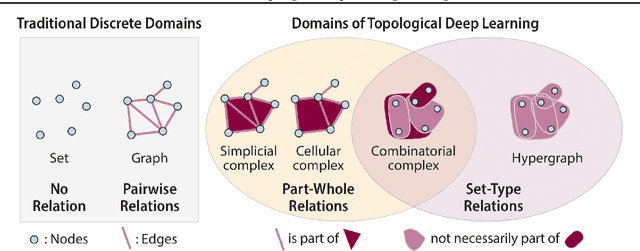
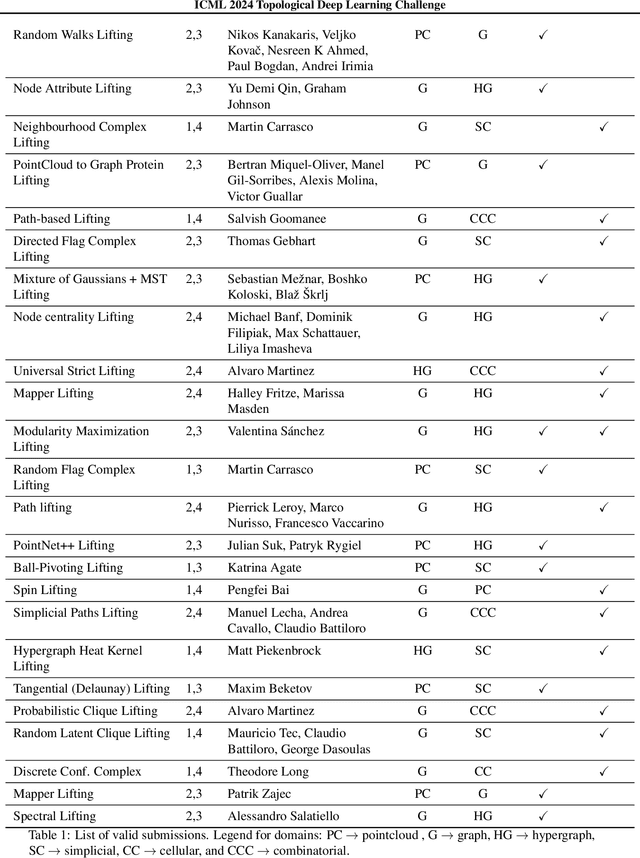
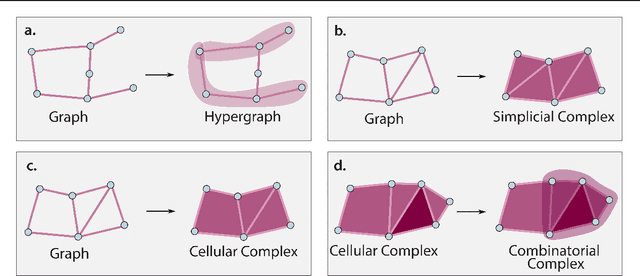
Abstract:This paper describes the 2nd edition of the ICML Topological Deep Learning Challenge that was hosted within the ICML 2024 ELLIS Workshop on Geometry-grounded Representation Learning and Generative Modeling (GRaM). The challenge focused on the problem of representing data in different discrete topological domains in order to bridge the gap between Topological Deep Learning (TDL) and other types of structured datasets (e.g. point clouds, graphs). Specifically, participants were asked to design and implement topological liftings, i.e. mappings between different data structures and topological domains --like hypergraphs, or simplicial/cell/combinatorial complexes. The challenge received 52 submissions satisfying all the requirements. This paper introduces the main scope of the challenge, and summarizes the main results and findings.
TopoBenchmarkX: A Framework for Benchmarking Topological Deep Learning
Jun 09, 2024Abstract:This work introduces TopoBenchmarkX, a modular open-source library designed to standardize benchmarking and accelerate research in Topological Deep Learning (TDL). TopoBenchmarkX maps the TDL pipeline into a sequence of independent and modular components for data loading and processing, as well as model training, optimization, and evaluation. This modular organization provides flexibility for modifications and facilitates the adaptation and optimization of various TDL pipelines. A key feature of TopoBenchmarkX is that it allows for the transformation and lifting between topological domains. This enables, for example, to obtain richer data representations and more fine-grained analyses by mapping the topology and features of a graph to higher-order topological domains such as simplicial and cell complexes. The range of applicability of TopoBenchmarkX is demonstrated by benchmarking several TDL architectures for various tasks and datasets.
Attending to Topological Spaces: The Cellular Transformer
May 23, 2024Abstract:Topological Deep Learning seeks to enhance the predictive performance of neural network models by harnessing topological structures in input data. Topological neural networks operate on spaces such as cell complexes and hypergraphs, that can be seen as generalizations of graphs. In this work, we introduce the Cellular Transformer (CT), a novel architecture that generalizes graph-based transformers to cell complexes. First, we propose a new formulation of the usual self- and cross-attention mechanisms, tailored to leverage incidence relations in cell complexes, e.g., edge-face and node-edge relations. Additionally, we propose a set of topological positional encodings specifically designed for cell complexes. By transforming three graph datasets into cell complex datasets, our experiments reveal that CT not only achieves state-of-the-art performance, but it does so without the need for more complex enhancements such as virtual nodes, in-domain structural encodings, or graph rewiring.
Position Paper: Challenges and Opportunities in Topological Deep Learning
Feb 14, 2024
Abstract:Topological deep learning (TDL) is a rapidly evolving field that uses topological features to understand and design deep learning models. This paper posits that TDL may complement graph representation learning and geometric deep learning by incorporating topological concepts, and can thus provide a natural choice for various machine learning settings. To this end, this paper discusses open problems in TDL, ranging from practical benefits to theoretical foundations. For each problem, it outlines potential solutions and future research opportunities. At the same time, this paper serves as an invitation to the scientific community to actively participate in TDL research to unlock the potential of this emerging field.
TopoX: A Suite of Python Packages for Machine Learning on Topological Domains
Feb 07, 2024
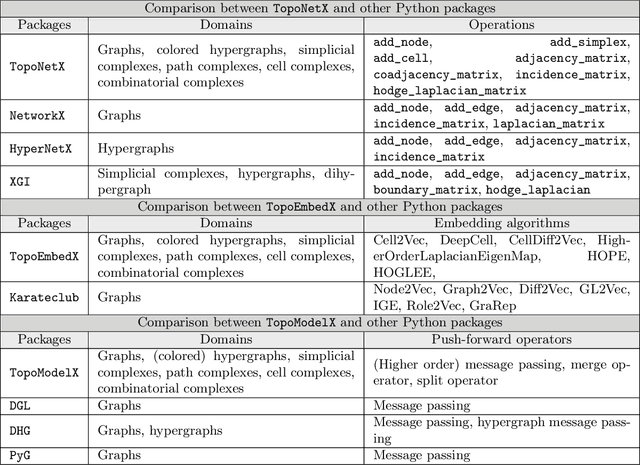
Abstract:We introduce topox, a Python software suite that provides reliable and user-friendly building blocks for computing and machine learning on topological domains that extend graphs: hypergraphs, simplicial, cellular, path and combinatorial complexes. topox consists of three packages: toponetx facilitates constructing and computing on these domains, including working with nodes, edges and higher-order cells; topoembedx provides methods to embed topological domains into vector spaces, akin to popular graph-based embedding algorithms such as node2vec; topomodelx is built on top of PyTorch and offers a comprehensive toolbox of higher-order message passing functions for neural networks on topological domains. The extensively documented and unit-tested source code of topox is available under MIT license at https://github.com/pyt-team.
Topo-MLP : A Simplicial Network Without Message Passing
Dec 19, 2023Abstract:Due to their ability to model meaningful higher order relations among a set of entities, higher order network models have emerged recently as a powerful alternative for graph-based network models which are only capable of modeling binary relationships. Message passing paradigm is still dominantly used to learn representations even for higher order network models. While powerful, message passing can have disadvantages during inference, particularly when the higher order connectivity information is missing or corrupted. To overcome such limitations, we propose Topo-MLP, a purely MLP-based simplicial neural network algorithm to learn the representation of elements in a simplicial complex without explicitly relying on message passing. Our framework utilizes a novel Higher Order Neighborhood Contrastive (HONC) loss which implicitly incorporates the simplicial structure into representation learning. Our proposed model's simplicity makes it faster during inference. Moreover, we show that our model is robust when faced with missing or corrupted connectivity structure.
Combinatorial Complexes: Bridging the Gap Between Cell Complexes and Hypergraphs
Dec 15, 2023

Abstract:Graph-based signal processing techniques have become essential for handling data in non-Euclidean spaces. However, there is a growing awareness that these graph models might need to be expanded into `higher-order' domains to effectively represent the complex relations found in high-dimensional data. Such higher-order domains are typically modeled either as hypergraphs, or as simplicial, cubical or other cell complexes. In this context, cell complexes are often seen as a subclass of hypergraphs with additional algebraic structure that can be exploited, e.g., to develop a spectral theory. In this article, we promote an alternative perspective. We argue that hypergraphs and cell complexes emphasize \emph{different} types of relations, which may have different utility depending on the application context. Whereas hypergraphs are effective in modeling set-type, multi-body relations between entities, cell complexes provide an effective means to model hierarchical, interior-to-boundary type relations. We discuss the relative advantages of these two choices and elaborate on the previously introduced concept of a combinatorial complex that enables co-existing set-type and hierarchical relations. Finally, we provide a brief numerical experiment to demonstrate that this modelling flexibility can be advantageous in learning tasks.
ICML 2023 Topological Deep Learning Challenge : Design and Results
Oct 02, 2023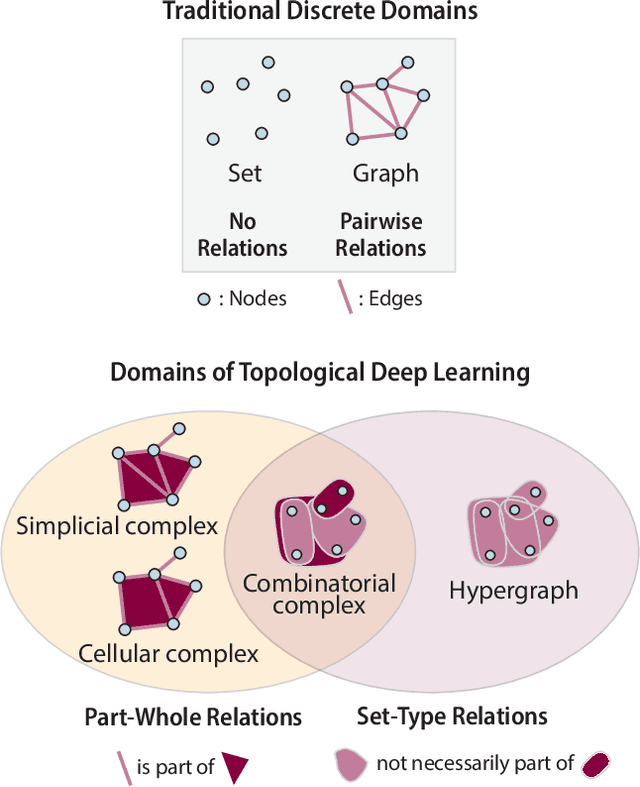
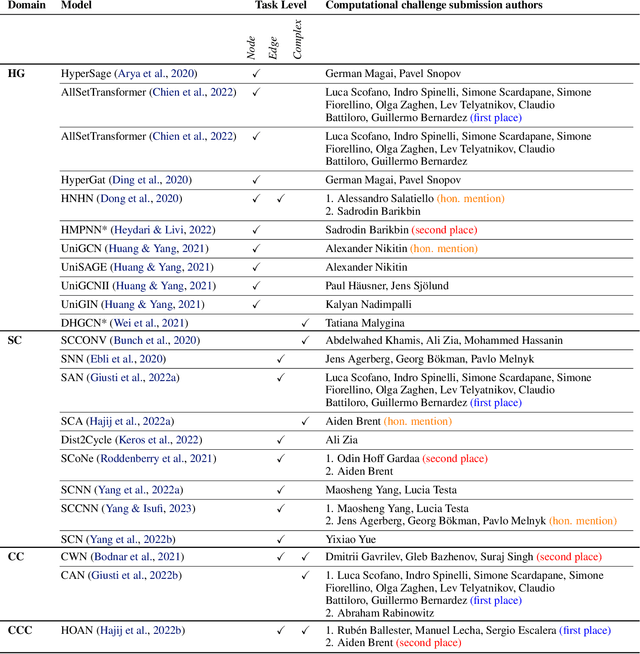
Abstract:This paper presents the computational challenge on topological deep learning that was hosted within the ICML 2023 Workshop on Topology and Geometry in Machine Learning. The competition asked participants to provide open-source implementations of topological neural networks from the literature by contributing to the python packages TopoNetX (data processing) and TopoModelX (deep learning). The challenge attracted twenty-eight qualifying submissions in its two-month duration. This paper describes the design of the challenge and summarizes its main findings.
 Add to Chrome
Add to Chrome Add to Firefox
Add to Firefox Add to Edge
Add to Edge